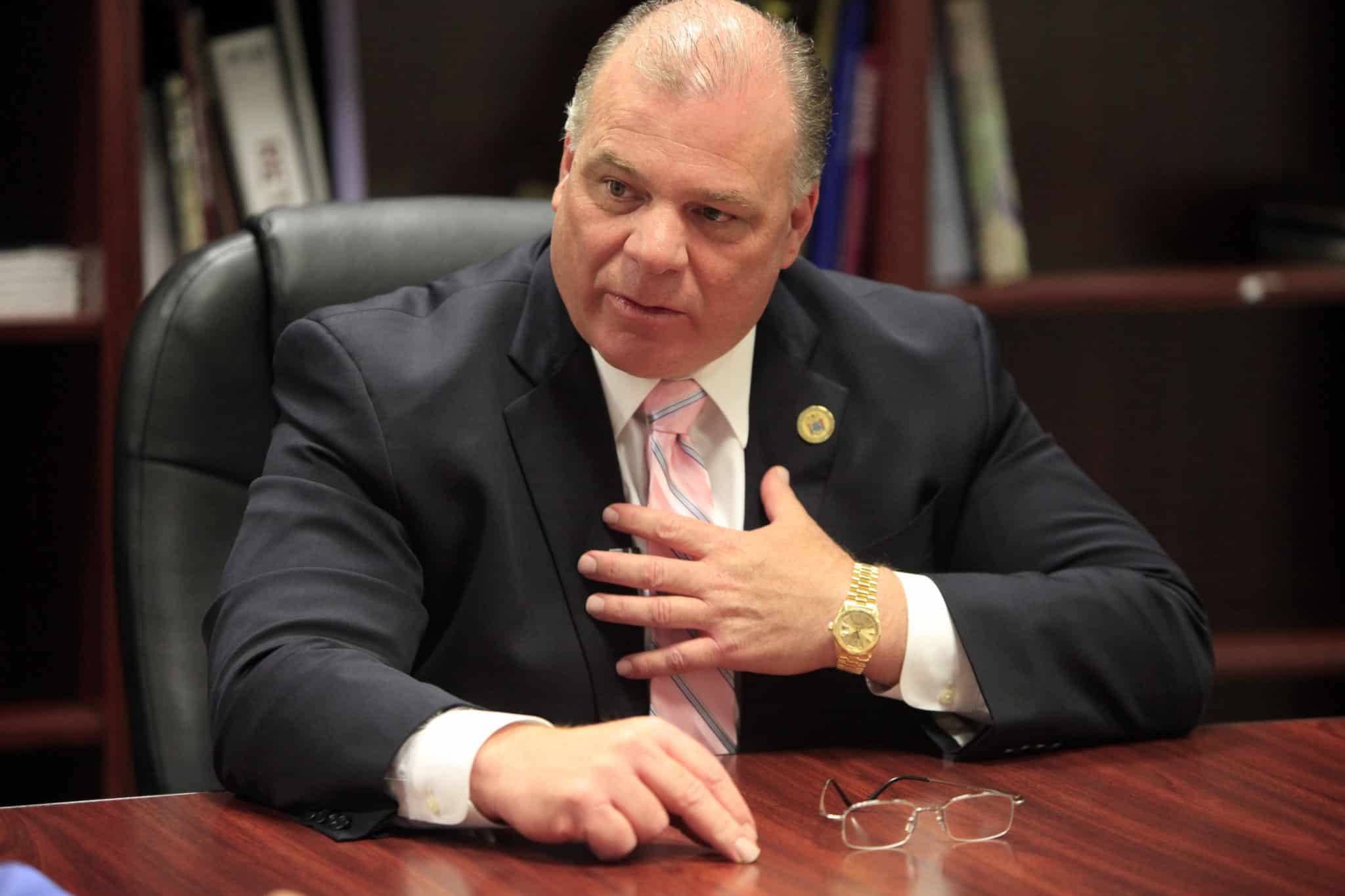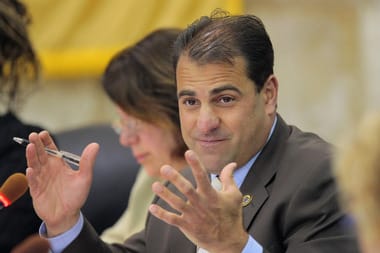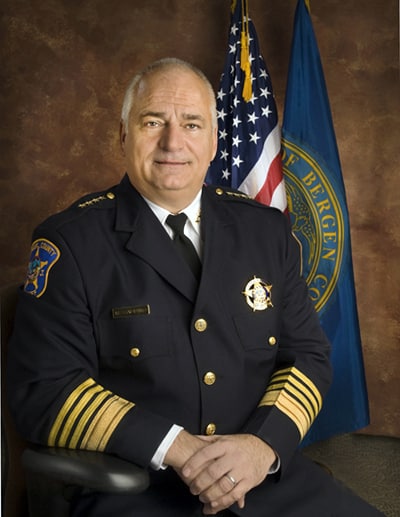
The leadership of Camden came out to hear the announcement. Mayor Dana Redd said it’s another step on the way to Camden’s becoming a world class city. Michael Aron, NJTV News Read more

The leadership of Camden came out to hear the announcement. Mayor Dana Redd said it’s another step on the way to Camden’s becoming a world class city. Michael Aron, NJTV News Read more

Friday, September 18, 2015
Executive Order Builds On Ongoing Preparation Efforts & Ensures Officials Have All Tools To Ensure A Safe And Orderly Visit
Trenton, NJ – With an estimated 2 million visitors expected to gather in Philadelphia for the upcoming World Meeting of Families and Papal visit, Governor Chris Christie today signed an Executive Order that puts in place measures to manage the occasion, coordinate any requests for mutual assistance with neighboring governments, and ensure a safe and orderly visit for New Jersey residents and many thousands of visitors expected to travel through New Jersey for the occasion. In effect, the Governor’s Order provides emergency management, law enforcement, county and local officials with the tools needed for a secure and orderly visit of His Holiness Pope Francis.
“Given the Pope’s comprehensive schedule and the influx of people traveling to see him, the events associated with his visit span the normal State, county and municipal operating services,” said Governor Christie. “Managing this historic event requires the coordinated deployment of personnel and other resources to ensure the health, safety and resources of the citizens of New Jersey.”
The order, which will remain in effect until Tuesday September 29, 2015 at 8:00 a.m., provides officials with the authority to accommodate mutual aid requests as well as contraflow of traffic on roadways and, consistent with the deployment of the National Guard in Philadelphia, authorizes use of the New Jersey National Guard to support events as needed.
According to Philadelphia officials, it is estimated that as many as 2 million people will attend the World Meeting of Families and Papal Mass on the Benjamin Franklin Parkway in Philadelphia. With tens of thousands of visitors travelling through the southwest region of New Jersey to access Philadelphia, gridlock on roadways within a 50-mile radius around the City is anticipated. In addition, as many as 250,000 additional vehicles and thousands of buses will be travelling through New Jersey into Philadelphia.
New Jersey officials already have put transportation plans in place:

By Mark Lagerkvist / September 17, 2015
New Jersey ranks worst in the country for state debt, according to a new nationwide study.
Each state taxpayer would need to pay $52,300 to erase New Jersey’s existing bills — including public pensions and retiree health benefits — reports Truth in Accounting, a think tank in Chicago.
Among “sinkhole states,” New Jersey was followed by Connecticut, $48,600 debt burden per taxpayer; Illinois, $45,000; Kentucky, $32,600; and Massachusetts, $27,400.
In the past year, the debt per taxpayer in New Jersey increased by $16,300, or 45 percent, according to the nonprofit.
The findings are consistent with a New Jersey Watchdog analysis of State Treasury records that found the Garden State’s pension and health benefit deficit for public workers is nearing $200 billion.
Earlier this week, New Jersey Watchdog reported:
New Jersey’s public pensions are underfunded by $113.1 billion. The state bears $80.5 billion of that burden. Local governments are responsible for the remaining $32.6 billion.
State and local governments are also on the hook for $81.4 billion in unfunded health benefits for retired and active workers. The state owes $65 billion; the local share is $16.4 billion.
The total shortfall is $194.5 billion – more than $60,000 per household. The figure is nearly six times higher than New Jersey’s total annual budget, currently $33.8 billion.
At the present pace, those unfunded liabilities will exceed $210 billion next year.
In its report, Truth in Accounting reported states have a combined total of $1.3 trillion in debt despite balanced budget requirements in 49 states.
The lack of truthful, timely and transparent financial information is increasing cynicism and mistrust and it is a risk for our representative form of government,” said Shelia Weinberg, CEO of Truth in Accounting. “Citizens do not have the information need to hold their politician accountable, much less cast an informed vote.”
The full study is scheduled for release next week.

State governments have had a hard time restoring budget reserves since the last recession, and New Jersey remains among those struggling the most, according to new state-by-state fiscal data released by The Pew Charitable Trusts. John Reitmeyer, NJSpotlight Read more

Three-fourths of NJ sheriffs double-dip, led by 25-year ‘retiree’
By Mark Lagerkvist / August 30, 2015 / 6 Comments
For the past quarter century, Armando Fontoura has been looting a New Jersey state pension fund. But it won’t do any good to call the cops.
Fontoura is sheriff of Essex County. A dean among double-dippers, he draws $207,289 a year from public coffers – $144,896 in salary plus $62,393 from pension as a retiree of his own office.
Today is the 25th anniversary of Fontoura’s faux retirement. So far, he has collected $1.35 million in retirement cash without ever giving up his full-time county paycheck
On Friday, Aug. 31, 1990, Fontoura retired as county undersheriff at age 47. The following Monday, he returned to work at Essex County with the same salary and duties, but a different title – sheriff’s officer chief. One year later, he took charge as sheriff, a post he’s held ever since.
“Does it look bad? Yes,” admitted Fontoura. “No question about it, it looks bad. Was it legal? Yes.”
Worse for taxpayers, three-fourths of New Jersey’s county sheriffs – plus hundreds of other public officials – are taking advantage of pension loopholes to collect dual incomes.
A continuing New Jersey Watchdog investigation found the sheriffs in 16 of the state’s 21 counties are double-dippers. In addition, the sheriffs also employ 37 undersheriffs who returned to work after retiring as local, county or state law enforcement officials at relatively young ages.
In total, the 53 officers collect nearly $10 million a year from public coffers – $5.7 million in salaries plus $4.1 million in retirement pay – according to payroll and pension records.
By order of annual incomes, the double-dipping posse includes:
Bergen County Sheriff Michael Saudino (R), $267,987 – $138,000 salary + $129,987 pension as an Emerson Borough police retiree
Passaic County Sheriff Richard H. Berdnik (D), $253,957 – $151,887 salary + $102,070 pension as a Clifton police retiree
Ocean County Sheriff Michael Mastronardy (R), $231,315 – $107,250 salary + $124,065 pension as a Toms River Township police retiree
Mercer County Sheriff John Kemler (D), $227,330 – $142,499 salary + $84,831 pension as a Mercer County sheriff’s office retiree
Camden County Sheriff Charles J. Billingham (D), $219,232 – $144,753 salary + $74,479 pension as a Washington Township police retiree
Somerset County Sheriff Frank J. Provenzano (R), $208,576 – $132,555 salary + $76,021 pension as Bridgewater Township police retiree
Warren County Sheriff David P. Gallant (R), $208,432 – $125,945 salary + $82,487 pension as a State Police retiree
Morris County Sheriff Edward V. Rochford (R), $200,838 – $139,203 salary + $61,545 pension as a Morris Township police retiree
Middlesex County Sheriff Mildred S. Scott (D), $200,796 – $139,455 salary + $61,341 pension as a retiree of the Middlesex County sheriff’s office
Hunterdon County Sheriff Frederick W. Brown (R), $197,796 – $115,868 salary + $81,928 pension as a retiree of Raritan Township police
Salem County Sheriff Charles M. Miller, $195,452 (R) – $119,386 salary + $76,066 pension as a retiree of the Salem County prosecutor’s office
Gloucester County Sheriff Carmel M. Morina (D), $191,996 – $128,547 salary + $63,449 pension as a Greenwich Township police retiree
Sussex County Sheriff Michael Strada (R), $170,124 – $121,212 salary + $46,973 pension as Mount Olive Township police retiree
Cumberland County Sheriff Robert Austino (D), $166,938 – $107,250 salary + $59,688 pension as a Vineland police retiree
Cape May County Sheriff Gary Schaffer (R), $161,654 – $107,500 salary + $54,154 pension as an Ocean City police retiree.
Click here for the complete list of sheriffs and undersheriffs who collect pensions plus salaries.
New Jersey Watchdog began tracking double-dipping by sheriffs in 2011. The initial report found 16 sheriffs and 28 undersheriffs collecting a total of $8 million a year – $3.25 million from pensions plus $4.75 million in salaries.
Four years later, the tally has increased by nine undersheriffs and $1.8 million a year in total pay.
The investigative news site has also reported extensively on double-dipping by state legislators, administration officials, school superintendents, state police and the staffs of the attorney general and county prosecutors.
RELATED: ‘Seven deadly sins’ of New Jersey pensions
The millions being drained from retirement funds through double-dipping epitomize the woes of a pension system that faces $170 billion in underfunding – a point noted earlier this year by Gov. Christie’s blue-ribbon, bi-partisan Pension and Health Benefit Study Commission.
“It has great symbolic importance…as the double-dippers have become the ‘face’ of a dysfunctional public pension system,” the study concluded, citing New Jersey Watchdog’s reporting. “For this reason, the task force should consider ways to further limit this practice.”
Yet Gov. Chris Christie and the State Legislature have done little to halt the abuses that have profited well-connected Democrats and Republicans over the years.
One of the bigger beneficiaries is Sen. Fred Madden, D-Washington, a triple-dipper who receives nearly a quarter-million dollars a year – $85,272 from his state police pension, $113,810 as dean of law and justice of Rowan College at Gloucester County and $49,000 as a part-time state legislator.
“Obviously I don’t have a problem with people doing it,” Madden said in an interview with New Jersey Watchdog three years ago. “I’ve accepted that in my own personal life. I don’t have a problem with it at all.”
A bill co-sponsored by Sen. Jennifer Beck, R-Red Bank, would stop most double-dipping. It would suspend pension payments to retirees who return to public jobs paying more than $15,000 a year. The retirement benefits would resume when they permanently leave public employment.
“The pension system is intended to support you at a time you are no longer working,” said Beck. “So when you are an active employee, you should not be able to tap into both.”
The reform proposal has gone nowhere since it was first introduced in 2011 by Beck and Sen. Steven Oroho, R-Sparta. Its current incarnations – S-883 and A-114 – are trapped in legislative committees, unable to get enough support to reach the Senate or Assembly floors for votes.
RELATED: 18 double-dipping lawmakers block pension reform
Meanwhile, Fontoura is a heavy favorite to win re-election as sheriff in a Democratic stronghold that includes Newark. A victory would enable him to continue his double-dipping ways in Essex County for at least three more years.
“I retired, I collect my pension, and I am your sheriff,” Fontoura told NBC 4 New York, which partnered with New Jersey Watchdog for a report in 2012.
County personnel records show the retiring and rehiring of Fontoura had been plotted in advance. Then-sheriff Thomas D’Alessio approved the move on Aug. 7, 1990, more than three weeks before the switch.
“I said, as long as I can do this legally without breaking any law – and I can collect my pension and augment it with a salary — that’s fine, I will do this,” Fontoura recalled.
The sheriff’s office did not respond to a new request from New Jersey Watchdog for additional comment

AUGUST 31, 2015 LAST UPDATED: MONDAY, AUGUST 31, 2015, 8:52 AM
BY KARA YORIO
STAFF WRITER | THE RECORD
North Jersey parents have always looked forward to a child’s first birthday. Not only is it a great milestone and cause for celebration, it was the point where the law allowed car seats to be flipped from rear-facing to forward-facing. As of Tuesday, that changes.
New Jersey law is falling in line with the American Academy of Pediatrics (AAP) recommendations, which have said that children should remain rear-facing until at least 2 years old or weighing more than 30 pounds.
“The science and studies are quite clear,” said Howard Mazin, an Englewood Hospital and Medical Center attending pediatrician, who has always urged his patients to keep their children rear-facing until age 2. “I know all parents want what’s safest for their kids.”
The other big change in the law is that kids should be in a booster seat until age 8 or 57 inches. Previously it was until 8 or 80 pounds. Children younger than 4 years old or under 40 pounds must be in a seat with a five-point harness (ideally rear-facing until hitting the limits set by the seat manufacturer) not a booster seat using the regular seat belt. The fines have also been raised from a minimum of $10 and maximum of $25 to a minimum of $50 and maximum of $75.

One State Has Officially Been Named the Most HATED State in the US
There’s 50 states. Not every one can get as much love as the others.
YouGov made a ‘State of the States,’ in which they asked Americans how they feel about each and every state.
This research shows that New Jersey is the only state in the U.S. which people tend to have a negative opinion of. 40% of Americans have an unfavorable opinion of the Garden State while 30% have a favorable opinion of the state, which gives the state a net favorability of -10%.
For comparison, Alabama, the second least popular state, has a net favorability rating of +8%,as 39% of Americans have a favorable view of Alabama and 31% have an unfavorable opinion.
After Alabama the least popular states are Illinois (+9%), Mississippi (+9%) and Indiana (+12%).
Read more: https://capitalismisfreedom.com/most-hated-state-in-the-us/#ixzz3kEtFqu6n

A Superior Court Judge today approved a $225 million settlement between the State and ExxonMobil to resolve liability for damage to the environment and injury to natural resources caused by contamination from the corporation’s refinery operations in Bayonne and Linden, as well as other facilities and service stations in New Jersey, Acting Attorney General John J. Hoffman and Department of Environmental Protection (DEP) Commissioner Bob Martin announced.
Politicker Staff, Politickernj Read more

Large crowds at a weekend beach concern have a state lawmaker more convinced than ever that his bill to give tax breaks to A-list performers that commit to multi-night stands in Atlantic City would give the struggling city a financial boost. (Wayne Parry, Associated Press) https://www.philly.com/philly/

file photo by Boyd Loving
“Public confidence in our police officers is absolutely positively vital,” said Acting Attorney General John Hoffman.
In a year of police shootings, community uproar and disturbing videos, Hoffman announced the expansion of body cameras in New Jersey.
(Michael Aron, NJTVNews)
https://www.njtvonline.org/

By Linda Stamato | NJ Voices
on July 19, 2015 at 5:54 PM, updated July 29, 2015 at 9:57 AM
The slogan reads “Your Interests, not Special Interests.”It’s available on a bumper sticker courtesy of theDemocratic Senatorial Campaign Committee. Seriously. I’d like to believe it. But I’d like to believe in tooth fairies too.
Here in New Jersey, as elsewhere, the slogan is more wishful thinking than reality. It’s not just the Democrats or even mostly them, but Republicans too. And when both political parties want to do favors for a special interest and join sides to do it, watch out! It’s then that even the “good guys” look the other way and others hold their noses and go along.
This is not what we mean by bipartisanship.
Case in point: George E. Norcross III, citizen of South Jersey, or as Tom Moran dubbed him, the Dark Lord, the second most powerful political force in New Jersey. What Mr. Norcross wants, evidently, Mr. Norcross gets. Both parties go along, and, at a fast clip. Recently, Norcross decided he wanted–for Cooper University Hospital–the paramedic service that Virtua Health has been providing in the city of Camden since 1977, even though Virtua has provided advanced life support and paramedic services, by all accounts, exceptionally well. So, why take it away? Because, we learn, Norcross said so. (And, he has “a history” with Virtua.)
A bill, S2980 /A-4526) was rushed through both houses to accomplish this act, pausing by a few committees that passed on it in less than a week, and it wound up on Christie’s desk where it was promptly signed. Ordinarily, for such a change to take place, a certification of need would be required. Not for Cooper. Not for Norcross. Why? Think about it. The certification process is transparent. It takes time. And, Cooper might not have prevailed. So, what to do? Bypass the process. That way the outcome is assured. And, by the way, not only did the governor not hesitate to sign off, he put $2.5 million into the budget to help buy the ambulances and the equipment Cooper “needs” to carry out its new responsibilities. What are friends for?

JULY 19, 2015 LAST UPDATED: SUNDAY, JULY 19, 2015, 12:35 AM
BY PATRICIA ALEX
STAFF WRITER |
THE RECORD
Kean University is launching an expensive architecture program, largely tailored to foreign students, at its Union campus despite another public one just 6 miles away at the New Jersey Institute of Technology.
The technology institute, virtually across the street from Rutgers Medical School in Newark, is considering partnering with Rowan University, just south of Philadelphia, to train doctors.
A new public business school is opening in Jersey City even as others in nearby Newark and Montclair are spending millions to beef up their programs.
If it seems like there’s no statewide plan for higher education in New Jersey, it’s because there isn’t, and recent decisions by the schools have raised questions about whether weak state oversight has allowed for expensive and duplicative projects that have helped make the state home to some of the highest public tuitions in the nation.
The politically appointed boards that run the state-subsidized colleges and universities have a degree of autonomy unheard of in most other states. And with no resistance from state officials, the boards have approved costly and controversial projects.
Stockton University bought an $18 million former casino it is now unable to use; Montclair State University agreed to spend $250,000 on a statue of its mascot and Kean purchased a multimedia conference table from China for $219,000, prompting a state investigation.

N.J. campaign committees continue to see fundraising decline
By Matt Friedman | NJ Advance Media for NJ.com
That’s the least amount raised for any legislative election year since at least 2007, though that’s in part because only the Assembly is on the ballot — the first time that’s happened since 1999. But Jeff Brindle, ELEC’s executive director, said much of that money has been or will be put into other channels.

July 16, 2015
By
Alan Cole,
Scott Drenkard
This week’s map shows the real value of $100 in each state. Prices for the same goods are often much cheaper in states like Missouri or Ohio than they are in states like New York or California. As a result, the same amount of cash can buy you comparatively more in a low-price state than in a high-price state.
The Bureau of Economic Analysis has been measuring this phenomenon for two years now; it recently published its data for prices in 2013. Using this data, we have adjusted the value of $100 to show how much it buys you in each state.
For example, Ohio is a low-price state. $100 there will buy you stuff that would cost $111.61 in a state closer to the national average. You could think of this as meaning that Ohioans are, for the purposes of day-to-day living, eleven percent richer than their incomes suggest.
The states where $100 is worth the most are Mississippi ($115.21) Arkansas ($114.29) South Dakota ($114.16) Alabama ($114.03) and West Virginia ($113.12). In contrast, $100 is effectively worth the least in the District of Columbia ($84.96) Hawaii ($86.06) New York ($86.73) New Jersey ($87.34) and California ($89.05.)
Regional price differences are strikingly large; real purchasing power is 36 percent greater in Mississippi than it is in the District of Columbia. In other words: by this measure, if you have $50,000 in after tax income in Mississippi, you would have to have after-tax earnings of $68,000 in the District of Columbia just to afford the same overall standard of living.
It’s generally the case that states with higher nominal incomes also have higher price levels. This is because there is a relationship between the two: in places with higher incomes, the prices of finite resources like land get bid up. But the causation also runs in the opposite direction. Places with high costs of living pay higher salaries for the same jobs. This is what labor economists call a compensating differential; the higher pay is offered in order to make up for the low purchasing power.
This relationship is important, though it is not the only thing that matters. Some states, like North Dakota, have high incomes without high prices. Adjusting incomes for price level can substantially change our perceptions of which states are truly poor or rich.
For example, Nebraskans and Californians earn approximately the same amount in dollars per capita, but after adjusting for regional price parity, Nebraskan incomes can buy more.
This has substantial implications for public policy, which is often progressive with respect to income.
Many policies – like minimum wage, public benefits, and tax brackets – are denominated in dollars. But with different price levels in each state, the amounts aren’t equivalent in purchasing power. This has some unexpected consequences; people in high-price-level states like New Jersey will often pay more in federal taxes without feeling particularly rich.

Fort Lee, NJ. was improperly included due to an error on the Sanctuary City map by Apsan Law Offices, our sincerest apologies
PJ Blogger and the Staff of the Ridgewood blog
New Jersey Sanctuary cities
Camden, NJ (Added in 2007; latest source: Camden, Immigrant Haven?, By Lauren Feeney, City Paper, 7-16-08)
Hightstown, NJ (Added 5-30-07)
Jersey City, NJ.
Newark, NJ (Added 6-3-07)
North Bergen, NJ.
Trenton, NJ.
Union City, NJ.
More items…
List of Sanctuary cities – Apsan Law Offices
www.apsanlaw.com/law-246.List-of-Sanctuary-cities.html
Kate Scanlon / @scanlon_kate / July 10, 2015
Is your city a sanctuary city?
The Center for Immigration Studies has released an interactive map depicting cities, counties and states that are “sanctuaries” for immigrants who are in the country illegally.
>>View interactive map here
The map shows over 200 sanctuary cities, counties and states nationwide.
Sanctuary cities are cities or jurisdictions where local authorities have chosen not to act in accordance with federal immigration laws.
According to the Center for Immigration Studies, “these state and local jurisdictions have policies, laws, executive orders, or regulations allowing them to avoid cooperating with federal immigration law enforcement authorities”:
[The cities] ignore federal law authorizing U.S. Immigration and Customs Enforcement (ICE) to administratively deport illegal aliens without seeking criminal warrants or convictions from federal, state, or local courts. Although federal law requires the cooperation, the Department of Justice has never sued or taken any measure, including denying federal funds, against a jurisdiction.
According to the map, North Dakota and Rhode Island are sanctuary states.
David Inserra, a research assistant at The Heritage Foundation, said that it is a “no brainer” for local and state officials to aid federal agencies in enforcing federal laws.
“Not enforcing the law results in lawlessness,” Inserra said.
https://dailysignal.com/2015/07/10/is-your-city-a-sanctuary-city-this-map-has-the-answer/